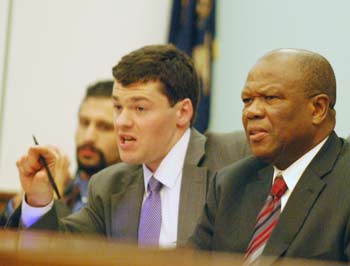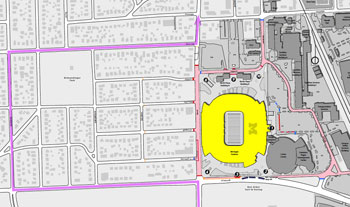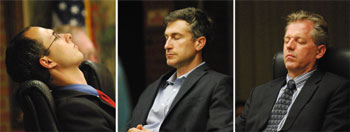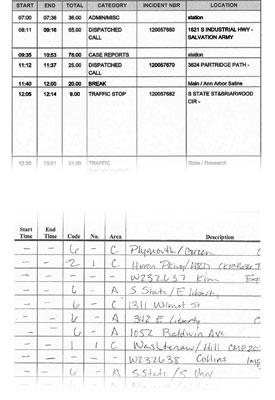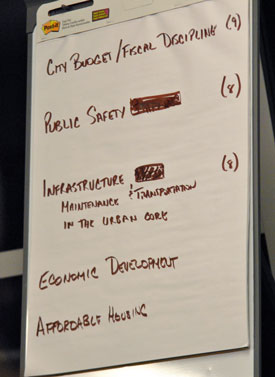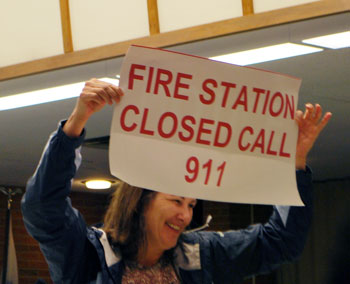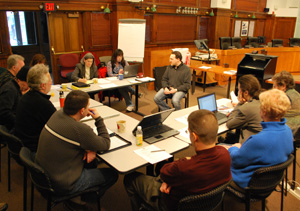Over the last month, the Ann Arbor city council has been using a series of working sessions to deliberate toward a final budget decision in late May. That’s when the council will need to adopt the city administrator’s proposed fiscal year 2014 budget, or make adjustments and adopt an amended budget. The city administrator’s proposed budget is due by April 15 – the council’s second meeting in April.

Chart 1: City of Ann Arbor two-year outlook for the general fund. The black bar represents recurring revenue. The stacked bars represent expenses. From the bottom up, those expenses are: existing recurring expenses (light red), requests for new recurring expenses (dark red), one-time requests (light blue), and capital improvement plan needs (dark blue). There also could be additional expenses needed to meet the city council’s priority goals.
The most recent of those work sessions took place on March 11, 2013. The agenda focused on the city council’s top priorities, as identified at its planning retreat late last year: (1) city budget and fiscal discipline; (2) public safety; and (3) infrastructure. Two additional areas were drawn from a raft of other possible issues as those to which the council wanted to devote time and energy over the next two years: (4) economic development; and (5) affordable housing. The retreat had resulted in a consensus on “problem” and “success” statements in these areas – answering the questions: (1) What is the problem we are solving? and (2) What does success look like?
The priority-focused March 11 work session followed one held on Feb. 25, which mapped out the financial picture for the next two years fund-by-fund – not just the general fund, but also the various utility funds (water, sanitary sewer, stormwater, and streets) and internal service funds (fleet, and IT). But on March 11, the council’s focus was primarily on the general fund – as deliberations centered on the first two priority items: fiscal discipline and public safety.
The Feb. 25 session had provided the council with a sketch of the basic general fund picture for the next two years, which is better than it has been for the last several years. Based on current levels for all services, recurring revenues for the two years are projected to exceed recurring expenses by a total of $1.44 million in a general fund budget of about $82 million each year.
That doesn’t factor in requests from various departments that would result in additional recurring expenses, totaling $1.17 million for the two years – which would leave a surplus of just $265,000. When further requests from departments are considered that would result in one-time expenses, that two-year surplus would flip to a deficit of about $252,00. And if all as-yet-unfunded capital improvement expenses are added in for the two years, the city would be looking at a two-year general fund deficit of $4.41 million.
The general fund’s uncommitted balance could cover that deficit – but it would leave the uncommitted balance at $9.69 million at the end of FY 2015, or 11.5% of operating expenses. Under city policy, the uncommitted general fund balance should be between 8% and 12%. However, Tom Crawford, the city’s chief financial officer, has recommended that the city strive for 15-20%.
None of those numbers factor in any additional resources that could be required to achieve success measured in terms of the city council’s priority goals.
At the March 11 session, discussion by councilmembers of the first two priority items – fiscal discipline and public safety – revealed some unsurprising philosophical differences in approach. The majority of councilmembers seemed to accept city administrator Steve Powers’ inclination to take FY 2014 as a “breather” year, not asking departments to meet reduction targets this year, after several years of cuts. But Jane Lumm (Ward 2) – who previously served as a Republican on the council in the mid 1990s, and was elected as an independent in 2011 – expressed disappointed with this approach. She wants reduction targets every year.
And Sumi Kailasapathy (Ward 1), who was elected in November 2012, challenged the idea that it’s only new councilmembers who need to learn during the budget process. She pointed out that city staff members also have a learning curve – as they shift the organization’s priorities to the new council’s priorities.
For public safety, a consensus seemed to emerge that the council’s planning retreat success statements about policing might need further refinement – in light of the current department’s configuration. Police chief John Seto characterized that configuration as set up to be reactive, not proactive. Current staffing levels don’t allow for a proactive configuration, he indicated.
But the council did not appear to have a complete consensus about the importance of that proactive capability – unless that capability could be linked to success in making the community be safe and feel safe. Measuring perceptions of safety through the National Citizens Survey – for the first time since 2008 – was an idea that seemed to have some traction on the council. Some sentiment was expressed that the number of police officers should be increased – whether or not that increase could be tied to better safety as defined in adopted city council goals.
For the fire protection side of public safety, councilmembers effectively made a decision – without voting – to give clear direction to fire chief Chuck Hubbard that they didn’t want to see his three-station plan implemented. He had first presented the plan about a year ago. The proposal would close three stations but re-open one, for a net reduction from five to three stations.
Some dissent was offered, but mayor John Hieftje indicated that in his view the three-station plan was dead. Still, councilmembers seemed unenthusiastic about an alternative – which would entail hiring an additional 23 firefighters to staff existing stations. They seemed more inclined toward incremental improvements in fire safety. Those improvements might be gained through community education. Another possibility is deployment of some light rescue vehicles, which would require a crew of just two, instead of water-carrying trucks that need a crew of three.
This report focuses exclusively on the top council priorities of budget discipline and public safety. Also discussed at the working session, but not included in this report, were draft work plans for the other three priority areas: infrastructure, economic development and affordable housing.
The council may schedule an additional work session on March 25 to give city administrator Steve Powers more direction as he shapes the final budget that he’ll submit to the council in April. [Full Story]




